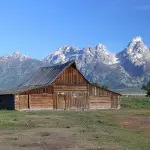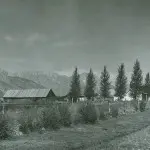Thomas Alma “Alma” Moulton first homesteaded this property in 1907 as a bachelor. He came over Teton Pass with his brother John and neighbor Thomas Perry from Teton Basin, Idaho. The Moultons had moved to Idaho from Utah several decades ago. For the first few winters, Alma continued to return to the family holdings in Idaho. By 1912, he had married and he brought his new wife, Lucile, over the Teton Pass to permanently settle in the Jackson Hole valley. Upon entering her crude one-room cabin to see how dirt had fallen through the roof to cover the few items of furniture, Lucile silently teared up. It would take hard and determined work to create a home out of the rough log walls. Today, what remains from his homestead is only a barn, but the barn has created a legacy beyond anything Alma Moulton or his children could have imagined. Billed as the “most photographed barn in America,” this structure had humble beginnings.
Thomas Alma Moulton’s ability to homestead his land in Jackson Hole began with his grandmother and grandfather’s harrowing journey to America in 1856. Thomas and Sarah Moulton were Mormons living in England, who were promised land and freedom of religion in Salt Lake City, Utah. They were one of hundreds of families who made the journey to settle the American west and spread the word of Mormonism. Days after departing England, Sarah gave birth to Charles Alma, their seventh child. It was considered a blessing that the infant survived the ocean voyage, but the family’s fight for survival would be far from over. Upon reaching Iowa via rail, they were assigned to the Fourth Handcart Company where they received supplies and two handcarts for the 1,300 mile journey to Utah. They reached Nebraska in August almost without trouble, but the handcarts were falling apart. Their leader, James Grey Willie wanted to press on despite being cautioned against attempting the dangerous route so late in the year. One of four companies attempting the journey, the Willie Company would suffer great losses in supplies and in members. News reached Brigham Young that hundreds of people were meeting certain death out on the Wyoming plains and a relief train was sent out to meet them.
On November 2nd, the relief train met the haggard handcart company at Fort Bridger, Wyoming. Up to 72 people had died, but the Moulton family was miraculously intact, Charles Alma was worse for the wear but survived. It was said that he was carried on a pillow for the journey, believed to be too frail for direct contact. His eight-year-old brother, Heber suffered the loss of the fingertips on his left hand due to frost bite, but this was the only major casualty for the family. Charles Alma would survive the ordeal and grow to be a healthy, strong young man. He married Frances Duke and the pair had a total of nine children, the eighth was Thomas Alma Moulton.
Alma Moulton began construction on the central portion in 1913 in order to give his hard working horses some shelter. The original barn had a flat roof, but it provided a necessary service for the Moulton family. In 1928 the hayloft and steeply pitched gable roof was added. By 1938 and 1939 two shed roofed lean-tos were added to the structure. First the north section for the horses, and the south section for the pigs. The continued addition of separate parts gives the barn a unique, but unintentional character that has achieved national recognition. Preservation efforts have been undertaken by both the Moulton family and Grand Teton National Park to ensure that this barn continues to illustrate the trials and successes of homesteading in Jackson Hole.
Alma and Lucile had six children that they raised on the ranch. As time and money permitted, they replaced their old log cabin with a wooden frame house. They were devout Mormons, and believed in serving the church and their community. Lucile was present for several dozen births up and down the Row as a midwife, often staying for a few days to help manage the house while the mother recovered. Alma lit the stove in the church each Sunday morning, and pioneered the paperwork to secure water rights to build an irrigation ditch from nearby Miracle Spring in 1929. After the Kelly flood in 1927, the “Mud Spring” began producing enough water to allow Mormon Row ranchers to irrigate their fields. Because the water was warm (today it is known as the Kelly Warm Spring), they could access the water year-round and the name was changed to Miracle Springs. Prior to this, they scraped by with dry farming. The advent of water made the small community exceptionally successful, having suitable soil and topography for raising wheat, oats and hay.
The seasons passed on Mormon Row, and the families continued to be self-sufficient, traveling into town once a year for the few supplies they could not readily make on their own. As the decades passed, however, life in the quiet valley would begin to change. In the mid-1920s, talk of preserving the area from further development began to spread. Interested parties began devising ways in which to prevent what they perceived to be the threat of imminent commercial development, especially as water rights in Idaho had resulted in a dam being built on Jackson Lake. Ultimately, it would be Horace Albright, the Superintendent of Yellowstone National Park who would bring a concerned John D. Rockefeller, Jr. into the valley. Rockefeller prized the wild scenic value of the area and wanted to purchase the homestead and ranch lands to donate to the federal government for protection. Rockefeller began plans to create a company to purchase the lands in the valley while keeping his name a secret. In 1927, the Snake River Land Company was formed.
Jackson Hole residents were highly suspicious of the Snake River Land Company’s motives. When news later broke in 1930 that a Rockefeller was secretly backing the company, and the lands he was purchasing would be donated back to the federal government, valley residents were incensed. They felt they had no say in what happened to the lands they had spent decades cultivating and creating livelihoods from. For most, survival on their 160 acres was difficult and any offer of money was enough to get off of the land that once seemed so promising. Taxes and mortgages were becoming harder and harder to pay off, and many felt that taking the Snake River Land Company’s offer was better than owing more money later. At Mormon Row, it was a very different story. When the Snake River Land Company began making offers on these lots, Governor Frank C. Emerson interceded, worried about this prime agricultural land being lost to state tax revenue. The residents along Mormon Row were concerned with missing an opportunity to sell their land before they became surrounded by protected federal lands. Those who wanted to sell wished to have the opportunity to do so.
By 1943, with the creation of the Jackson Hole Monument and the later 1950 expansion of Grand Teton National Park, only the Moultons would remain as private landowners on the Row. Alma’s brother John sold with a life lease in 1953. What no one expected was that he would live to be 103 years old, and the National Park Service would not acquire his property until 1990. Alma Moulton was convinced to hold onto his parcel for another decade, and to allow the next generation to take over. This was a rare occurrence in the valley, as many sold due to children moving away from the hard life of ranching. Alma deeded his son Clark one acre of his land for the construction of a house and barn. In 1963, the other 159 acres were sold to Grand Teton National Park under a life lease. Despite Clark’s retirement in 1987, he and his wife Veda chose to keep the one acre parcel for future generations. It survives as such today, and Alma’s great-grandchildren continue to live on one of the only privately-held parcels of land within Grand Teton National Park.
TIMELINE
1907: Thomas Alma “Alma” Moulton first travels to Jackson Hole intent on setting up a homestead claim. He starts work, but returns home to Idaho each winter to make money sheep herding.
1912: After constructing a cabin, fencing and cultivating land, Moulton brings his wife Lucile and infant son, Clark over Teton Pass to move permanently to Jackson Hole.
1913: The first portion of what would become “the most photographed barn in America” is constructed. Just a small box with a flat roof, it was only intended to be winter lodging for the Moulton’s two work horses.
1928: Moulton adds the now iconic hayloft with steeply pitched gable roof and extended eaves.
1929: The Snake River Land Company begins buying up parcels around the valley. Residents become suspicious of the intentions of the mysterious company.
1938-9: The north and south shed-roof additions are added to house pigs and additional horses. The barn as it looks today is finally completed.
1943: The Jackson Hole National Monument is signed into law by President Franklin Roosevelt. The order effectively land locks Mormon Row within protected federal lands.
1950: The expansion of Grand Teton National Park now encompasses the Row, prompting many families to sell their lands to the National Park Service and retire. The Moultons hold on, but it becomes difficult watching friends and family move away from a once busy, bright community.
1953: John Moulton sells his property to the National Park Service. He retains a life lease and continues to live on the property until old age requires his move to Jackson. He would live to 103 years old, finally relinquishing his home on Mormon Row in 1990.
1963: T. Alma Moulton sells his land to Grand Teton National Park, keeping an acre lot for himself and his family. Today this one acre lot is one of few privately owned pieces of land in the valley. Descendants of T. Alma Moulton still live on the property and rent out the Moulton Ranch Cabins.
1987: Clark and Veda Moulton retire, but refuse to sell their private acre of land. They keep it with the intention of passing it on to future generations. Today their great-grandchildren live on the acre inherited from their legacy.
Text by Samantha Ford, Director of Historical Research and Outreach


